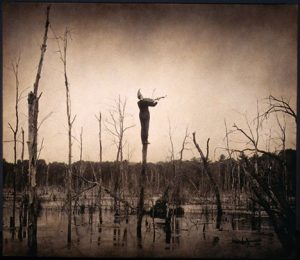
![]() William Wegman is known throughout the world for his inventive and witty photographs featuring his Weimaraner dogs in a variety of whimsical poses and guises. October 1981, Rangeley, Maine is a portrait of his first model, a dog named Man Ray, hidden under a layer of fall leaves. Man Ray sits below a sign forbidding hunting, trapping, or firearms that has ironically been used for target practice. A breed employed as hunting dogs, this camouflaged Weimaraner seems dressed to defy the edict, although his hunched pose conveys a mood of resignation.
William Wegman is known throughout the world for his inventive and witty photographs featuring his Weimaraner dogs in a variety of whimsical poses and guises. October 1981, Rangeley, Maine is a portrait of his first model, a dog named Man Ray, hidden under a layer of fall leaves. Man Ray sits below a sign forbidding hunting, trapping, or firearms that has ironically been used for target practice. A breed employed as hunting dogs, this camouflaged Weimaraner seems dressed to defy the edict, although his hunched pose conveys a mood of resignation.

For Wegman, Maine is a kind of Eden, offering escape from his busy life in New York. As he puts it, “Nothing bad happens in Maine….”[footnote]For a delightful romp through Wegman’s fascination with nature, see William Wegman, Hello Nature (Brunswick, Maine: Bowdoin College Museum of Art, 2012).[/footnote] He often works in the fall, posing Man Ray’s successors in bucolic settings. Wegman first encountered the Rangeley Lakes Region as a teenager, and he has spent summers there for over three decades. Nature has also played an important part in Wegman’s art, going back to his book, Field Guide to North America and Other Regions, published in 1993, which featured paintings, drawings, and essays about the natural world.

Like the work of Robert and Shana ParkeHarrison, Wegman’s oeuvre is marked by a purposeful naïveté that combines humor with a deeper critique of ways that nature has been both revered and altered by humans.